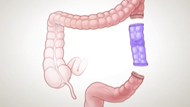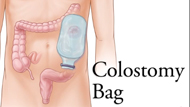Bowel Obstruction
Topic Overview
What is a bowel obstruction?
A bowel obstruction happens when either your small or large intestine is partly or completely blocked. The blockage prevents food, fluids, and gas from moving through the intestines in the normal way. The blockage may cause severe pain that comes and goes.
This topic covers a blockage caused by tumors, scar tissue, or twisting or narrowing of the intestines. It does not cover ileus, which most commonly happens after surgery on the belly (abdominal surgery).
What causes a bowel obstruction?
Tumors, scar tissue (adhesions), or twisting or narrowing of the intestines can cause a bowel obstruction. These are called mechanical obstructions.
In the small intestine, scar tissue is most often the cause. Other causes include hernias and Crohn's disease, which can twist or narrow the intestine, and tumors, which can block the intestine. A blockage also can happen if one part of the intestine folds like a telescope into another part, which is called intussusception.
In the large intestine, cancer is most often the cause. Other causes are severe constipation from a hard mass of stool, and narrowing of the intestine caused by diverticulitis or inflammatory bowel disease.
What are the symptoms?
Symptoms include:
- Cramping and belly pain that comes and goes. The pain can occur around or below the belly button.
- Vomiting.
- Bloating and a large, hard belly.
- Constipation and a lack of gas, if the intestine is completely blocked.
- Diarrhea, if the intestine is partly blocked.
Call your doctor right away if your belly pain is severe and constant. This may mean that your intestine's blood supply has been cut off or that you have a hole in your intestine. This is an emergency.
How is a bowel obstruction diagnosed?
Your doctor will ask you questions about your symptoms, other digestive problems you've had, and any surgeries or procedures you've had in that area. He or she will check your belly for tenderness and bloating.
Your doctor may do:
- An abdominal X-ray, which can find blockages in the small and large intestines.
- A CT scan of the belly, which helps your doctor see whether the blockage is partial or complete.
How is it treated?
Most bowel obstructions are treated in the hospital.
In the hospital, your doctor will give you medicine and fluids through a vein (IV). To help you stay comfortable, your doctor may place a tiny tube called a nasogastric (NG) tube through your nose and down into your stomach. The tube removes fluids and gas and helps relieve pain and pressure. You will not be given anything to eat or drink.
Most bowel obstructions are partial blockages that get better on their own. The NG tube may help the bowel become unblocked when fluids and gas are removed. Some people may need more treatment. These treatments include using liquids or air (enemas) or small mesh tubes (stents) to open up the blockage.
Surgery is almost always needed when the intestine is completely blocked or when the blood supply is cut off. You may need a colostomy or an ileostomy after surgery. The diseased part of the intestine is removed, and the remaining part is sewn to an opening in the skin. Stool passes out of the body through the opening and collects in a disposable ostomy bag. In some cases, the colostomy or ileostomy is temporary until you have recovered. When you are better, the ends of the intestine are reattached and the ostomy is repaired.
If your blockage was caused by another health problem, such as diverticulitis, the blockage may come back if you don't treat that health problem.
Related Information
References
Other Works Consulted
- Parangi S, Hodin R (2006). Intestinal obstruction. In MM Wolfe et al., eds., Therapy of Digestive Disorders, 2nd. ed., pp. 819-833. Philadelphia: Saunders Elsevier.
Credits
ByHealthwise Staff
Primary Medical Reviewer E. Gregory Thompson, MD - Internal Medicine
Adam Husney, MD - Family Medicine
Specialist Medical Reviewer Kenneth Bark, MD - General Surgery, Colon and Rectal Surgery
Current as ofMay 5, 2017
- Top of Page
Next Section:
Related Information
Previous Section:
Topic Overview- Top of Page
Next Section:
References
Previous Section:
Related Information- Top of Page
Next Section:
Credits
Previous Section:
References- Top of Page
Current as of: May 5, 2017





